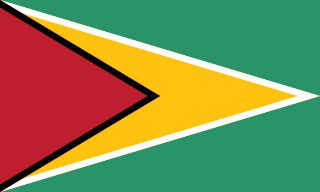Related Research Articles

The Guiana Shield is one of the three cratons of the South American Plate. It is a 1.7 billion-year-old Precambrian geological formation in northeast South America that forms a portion of the northern coast. The higher elevations on the shield are called the Guiana Highlands, which is where the table-like mountains called tepuis are found. The Guiana Highlands are also the source of some of the world's most well-known waterfalls such as Angel Falls, Kaieteur Falls and Cuquenan Falls.

The Guiana Space Centre, also called Europe's Spaceport, is a European spaceport to the northwest of Kourou in French Guiana, a region of France in South America. Kourou is located approximately 310 mi (500 km) north of the equator, at a latitude of 5°. In operation since 1968, it is suitable as a location for a spaceport, because of its equatorial location and open sea to the east.

British Guiana was a British colony, part of the mainland British West Indies, which resides on the northern coast of South America. Since 1966 it has been known as the independent nation of Guyana.

The Guyana national football team, nicknamed the Golden Jaguars, represents Guyana in international football and is controlled by the Guyana Football Federation. It is one of three South American nations to be a member of the Caribbean Football Union of CONCACAF alongside Suriname and French Guiana. Until the independence of Guyana in 1966, it competed as British Guiana. They qualified for the Caribbean Nations Cup in 1991, coming fourth, and in 2007. Guyana has never qualified for the FIFA World Cup, but on 23 March 2019 they qualified for the first time for the CONCACAF Gold Cup.

The French Guiana national football team is the regional football team of the French overseas department and region of French Guiana, and is controlled by the Ligue de Football de Guyane, the local branch of Fédération Française de Football.

The Guianas, sometimes called by the Spanish loan-word Guayanas, is a region in north-eastern South America which includes the following three territories:

French Guiana is an overseas department/region and single territorial collectivity of France on the northern Atlantic coast of South America in the Guianas. It borders Brazil to the east and south and Suriname to the west.

Epirrhoe is a genus of moths in the family Geometridae erected by Jacob Hübner in 1825.

Suriname was a constituent country of the Kingdom of the Netherlands between 1954 and 1975. The country had full autonomy, except in areas of defence and foreign policy, and participated on a basis of equality with the Netherlands Antilles and the Netherlands itself in the Kingdom of the Netherlands. The country became fully independent as the Republic of Suriname on 25 November 1975.

Surinam, also unofficially known as Dutch Guiana, was a Dutch plantation colony in the Guianas, bordered by the equally Dutch colony of Berbice to the west, and the French colony of Cayenne to the east. It later bordered British Guiana from 1831 to 1966.

Colobotheini is a tribe of longhorn beetles of the subfamily Lamiinae.
Acanthoderes latevittata is a species of beetle in the family Cerambycidae. It was described by Per Olof Christopher Aurivillius in 1921.
Hilobothea is a genus of longhorn beetles of the subfamily Lamiinae.

Menesia is a genus of longhorn beetles of the subfamily Lamiinae, containing the following species:
Melanothrix latevittata is a moth in the family Eupterotidae. It was described by Karl Grünberg in 1914. It is found on Borneo. The habitat consists of upper montane forests.
Hilobothea caracensis is a species of beetle in the family Cerambycidae. It was described by Monné and Martins in 1979. It is known from Brazil.
Frea latevittata is a species of beetle in the family Cerambycidae. It was described by Stephan von Breuning in 1970.
Glenea latevittata is a species of beetle in the family Cerambycidae. It was described by Per Olof Christopher Aurivillius in 1920 and is known from Borneo.
Menesia latevittata is a species of beetle in the family Cerambycidae. It was described by Stephan von Breuning in 1954. It is known from Borneo.
Planodema flavovittata is a species of beetle in the family Cerambycidae. It was described by Stephan von Breuning in 1947.
References
- ↑ BioLib.cz - Hilobothea latevittata. Retrieved on 8 September 2014.